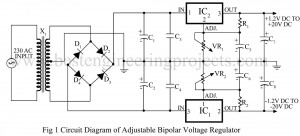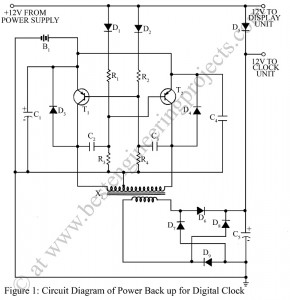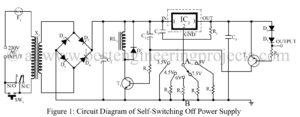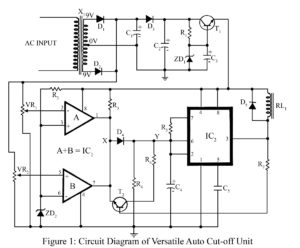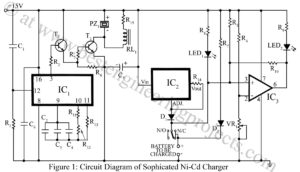For op-amp circuits, the power supply must provide positive and negative voltages. Here is a simple circuit “Adjustable Bipolar Voltage Regulator” which gives a regulated ± 1.2V to ±2oV supply. ICs LM317K (IC1) and LM337K (IC2) are used here as positive and negative regulators respectively. Circuit Description of Adjustable Bipolar Voltage Regulator using LM337 The circuit diagram of the adjustable bipolar voltage regulator using LM337 is shown in figure 1, and is designed using two positive and negative adjustable voltage regulator IC, a step-down transformer, a bridge rectifier, and a…
Read MoreCategory: power supply
Power Backup Circuit For Digital Clocks
The usual method of using a 9V battery for backup in digital clocks, though common, is not very desirable for many reasons. The cost of the battery and the very short life are some of them. Circuit Description of Power Back-up Circuit for Digital Clock The circuit described here is a Power backup Circuit for a digital clock and it enables us to get the required 9V from just two penlight cells. Initially one has to invest in this circuit power backup for a digital clock, in the long run,…
Read MoreSelf Switching Off Power Supply Circuit
This Self Switching Off Power Supply Circuit switches itself off when no current is drawn by the load. When a load current flows, the potential difference across diode D6 is sufficient to cause diode D7 = and transistor T2 to conduct. Transistor T1 is then switched on and the relay is energized. If you are new to relay drive circuits then you can watch this making video on How to make relay switching circuits. When the load current ceases, T2 switches off. The base current of T1 then charges capacitor…
Read MoreVersatile Auto Cut -Off Unit
A versatile auto cut-off facility is necessary for all the mains operated equipment and voltage stabilizers (automatic as well as manual) to switch them off when the voltage shoots above or falls below a certain safe level. The cut-off facility available in most commercial stabilizers is so abrupt that they switch off the moment the voltage goes beyond a predetermined window (normally, 180V to 250V) and switch on immediately after the voltage fall within the calibrated range. Introduction to Versatile Auto Cut-Off Unit Power interruptions are quite frequent at times…
Read MoreHow to Build a Reliable Ni-Cd Battery Charging Circuit: Step-by-Step Guide
Introduction to Ni-Cd Battery Charger Circuits Nickel-cadmium (Ni-Cd) batteries are commonly found in all sorts of household electronics and gadgets. Because these batteries go through frequent use and constant charging and discharging, having a dependable and efficient charger is essential. In this guide, we’ll walk you through a tried-and-true Ni-Cd battery charging circuit designed to safely recharge your batteries while including important protection features to keep everything running smoothly. Features of the Ni-Cd Battery Charger Circuit This Ni-Cd battery charger is designed to charge seven Ni-Cd pencil cells in series…
Read More